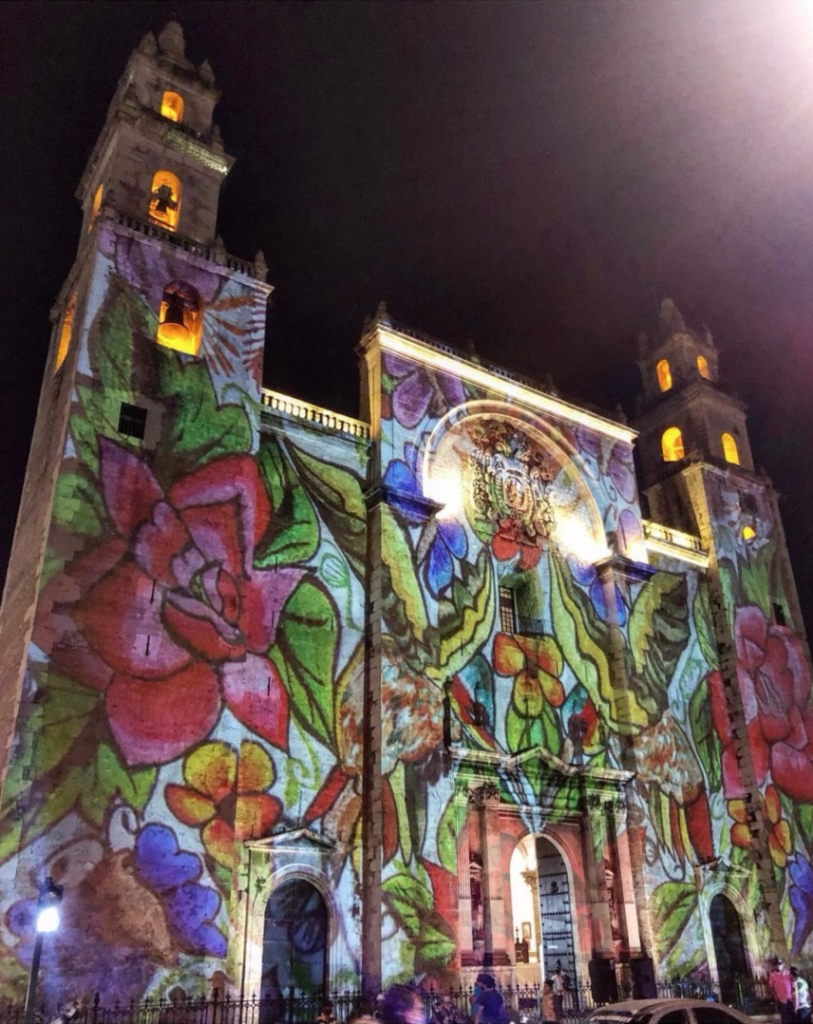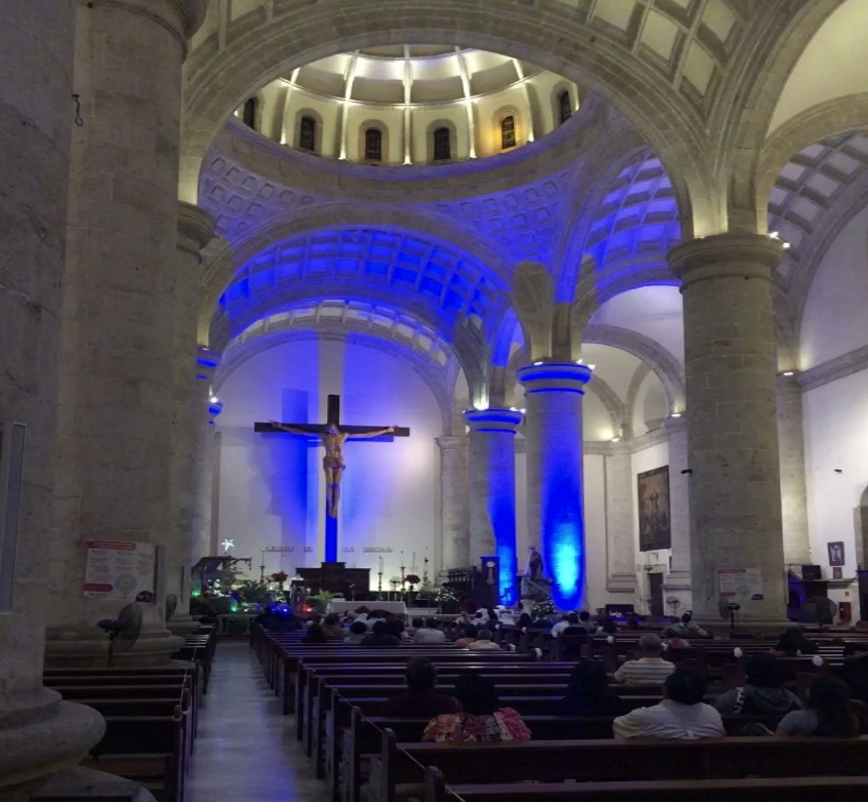Obiter Dictum
Okay, I admit I’m just showing off by using the above title. I liked the sound but I did have to look up the meaning (so much for my two years of formally studying Latin and endless years of hearing it in church). It means, by the way, “incidental remark”.
Remember the line to be checked (or, horrors, not!) in grade school report cards (at least in public schools): “Accepts criticism courteously”. Sometimes I received a check; sometimes, alas, not. I’m afraid the “alas” may apply here.
I do get comments on some posts. Most are supportive, encouraging, perceptive and insightful. Some are, of course, critical. I like to bask in the former and learn from the latter. Here’s what I learned from the one below:
Last week I had posted a picture of a light display projected on a cathedral in Mexico which I used as a metaphor for what I wished for as a new Church for a New Year, decade, millennium. It was one I envisioned as more inclusive, life and nature-affirming, nurturing and inspiring, all of which I labeled as a more feminine-influenced Church.
A male reader, whom I know personally and greatly respect, responded: “I find it hard to see what’s in the picture as “feminine.” The notable male (and probably female) painters in the history of art would have been surprised to find their representations of flora in nature and experimentations with bright or pastel colors characterized as feminine. From my viewpoint, it looks as if your theoretical lens may have colored your interpretation, which is probably in line with your expected readership.”
Referring to my picture and commentary about the inside of a cathedral which emphasized the feminine in its art and altar displays, he continued: I also failed, at the time and in retrospect, to notice the feminine influence everywhere in the Campeche interior. It looked and looks to this untrained eye very similar to the many church interiors I’ve seen in Spain and Italy, even Germany–only with much more silver. Mariolatry seems to have been a constant in medieval and counter-reformation iconography, even down to Mary Magdalen, and these celebrations of the women in Christian mythology were unlikely to have been allowed to be created by women in the 15th to 18th centuries. But maybe I’m missing your point here, misinterpreting what you mean by “feminine.”
He ended by commenting on the Merida Cathedral’s interior which I had described as “a metaphor for our Church today, lofty, but mostly empty. Even on Christmas, there are few attendees. The blue lighting is gorgeous and calming but somehow melancholy, too. The sorrowful, suffering Christ is once again in the forefront, perhaps appropriate for the sorrowful, suffering world in which we live, but it is Christmas. There are other possibilities inherent in its messages and, still and always, an abundance of hope.”
He partially agreed: “I think your characterization of ‘lofty, but almost empty’ for the Merida interior photo captures the sense of the scene. So many of the parishioners have probably been lost to secularism or evangelical Protestantism that the Catholic churches in Mexico are being drained of attendees.”
Then a hint of sarcasm took over: “I loved the blue light on the beige stonework and the stark crucifix in a surprisingly Romanesque architectural framework. The simplicity and abstraction must have appealed to my masculine receptors or masculine aesthetic sense (the “male gaze”)–except I don’t think those expressions have any meaning except within the confines of an ideology.”
He ended the commentary with: “Without a religious or conscious gender-based framework, I saw things differently. So, I can enjoy and be moved by religious art but not in the same way as a religious person, and although I think there are differences in the way people perceive things, I haven’t been convinced that gender differences, or biological sexual differences, account for as many of these perceptual differences as many others believe.”
I’m not denying that he made some valid points (Look at me “accepting criticism courteously”!), but I also had to do some deconstructing of their intention. Were the examples he gave on how to view art without gender bias merely to support his own argument? Fair enough. Or did they contain a hint of “mansplaining” applied to me. Not fair.
I know him personally, and so I suspect the former was true. He is a person who provides concrete, well-reasoned support for his critiques. Am I a person, I wondered, who does not? Then I thought, why was I feeling so defensive? My immediate reaction, besides noting he had totally missed the point of my post, was to ask why did he think I or my “expected readership” (aka. you) needed to be told that art was to be viewed through aesthetic, not just gender-biased eyes, and then add that male artists painting colorful flora would have been “surprised” (I thought a condescending choice of words) by my statement. Are we not savvy enough to know about the value of aesthetic appreciation? Do we need it explained to us? And, even given that fact, can we still not use some of what the world presents to us as a metaphor, in this case for a missing or neglected or ignored perspective, all of which had been the real point of my essay? A projected floral display – life, birth, growth – or crucified Christ – suffering, death (not even resurrection, Christ is still on the cross in most of our churches) – as metaphor? One has predominated throughout the ages because solely male leaders have predominated. The other seemed to be more feminine or other-gendered because it was the other, missing side. Well, rightly or wrongly, that is how I saw it.
His conclusion that he still remains unconvinced that gender differences might be a significant factor in how we view the world is what we are up against all the time. Gender is a major concern only because one viewpoint, especially within the Church hierarchy, unremittingly prevails. Excluding others so stringently for so long has done – and will continue to do if we don’t keep working for reform – profound damage. But you know that. Now I’m doing “womansplaining” I guess…but I’m tempted to add – and it’s about time!
To lighten up a bit on the point though, I include this poem by Wendy Cope– for the men of the Church hierarchy and their supporters – not for the man above who sent the comment nor for all the amazing men who support the inclusion and leadership and ministry of all genders. I ask the former, to learn, and all the latter: just enjoy!
Differences of Opinion
He tells her that the earth is flat —
He knows the facts, and that is that.
In altercations fierce and long
She tries her best to prove him wrong.
But he has learned to argue well.
He calls her arguments unsound
And often asks her not to yell.
She cannot win. He stands his ground.
The planet goes on being round.



2 Responses
Love that poem, Ellie! Thanks for sharing! People often don’t recognize the systems that provide their privilege, and have the privilege of not having to identify themselves. Until quite recently a white person rarely would feel the need to identify as such. The dominant gender group could always assume that his point of view was the accepted on and obviously true–and many men have trouble giving that up. Wendy Cope’s poem says all that clearly, and with a smile.
Sexuality is constitutive of the human person but does not exhaust the human person. Consider:
http://www.pelicanweb.org/solisustv18n01page24.html